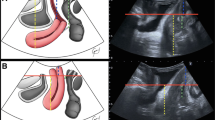Abstract
The qualitative and quantitative effects of bladder and vaginal balloon volumes on the sonographic diagnosis of paravaginal defects were evaluated. Transabdominal ultrasound measurements were performed on patients with stage 4 prolapse and coexisting paravaginal defects (study group) as well as on nulliparous patients without prolapse or paravaginal defects (control group). Paravaginal defects were measured, first without a water-filled condom in the vagina, and then sequentially with a 30, 60 and 90 ml water-filled balloon in the vagina at bladder volumes of 150 and 300 ml. Paravaginal defects were detected on transabdominal ultrasound in both groups. In both the study and the control groups the size of the paravaginal defect was directly related to the size of the balloon placed in the vagina (P<0.0001). There were no significant differences in the size of the paravaginal defects measured at a bladder volume of 150 ml compared to those measured at 300 ml. We conclude that transabdominal ultrasound is not useful in detecting paravaginal defects.
Similar content being viewed by others
Author information
Authors and Affiliations
Rights and permissions
About this article
Cite this article
Nguyen, J., Hall, C., Taber, E. et al. Sonographic Diagnosis of Paravaginal Defects: A Standardization of Technique. Int Urogynecol J 11, 341–345 (2000). https://doi.org/10.1007/s001920070003
Published:
Issue Date:
DOI: https://doi.org/10.1007/s001920070003




